Hat, umbrella and horse tail are the banners of samurai!
Then the system of official ranks (the basis was taken in China) divided the entire ruling class into 12 levels (or ranks). Each rank was supposed to wear a dress of a strictly specific color, which was a kind of symbol (or rather, standard) of each bureaucratic class. And so on until the end of the XIX century. - the color of the “business” clothes of the Japanese indicated that they belonged to one rank or another.
The warriors (otherwise they were called samurai, or busi) initially had no place in the established system of ranks. Until the XII century. they were openly despised by high-ranking officials (for which, however, the latter later paid dearly).
Standards of famous commanders in the battle of Osaka. Fig. A.Shepsa
In addition to personal insignia, military clans, formed in the 9th-11th centuries, had their own distinctive signs, common to all members of the genus. First of all, it was a banner (hata-jirushi), which was a long, narrow panel, fixed on the transverse crossbar with its upper part. That was attached to the middle on a vertical pole. It turned out something similar to banners, but the width of 60-90 cm and 8-10 times as long. The lower end of the cloth, as a rule, was not fixed, which made it possible for the banner to wave freely in the wind. Hata-jirushi Tyra and Minamoto had differences only in color - the former had red flags, the latter had white.
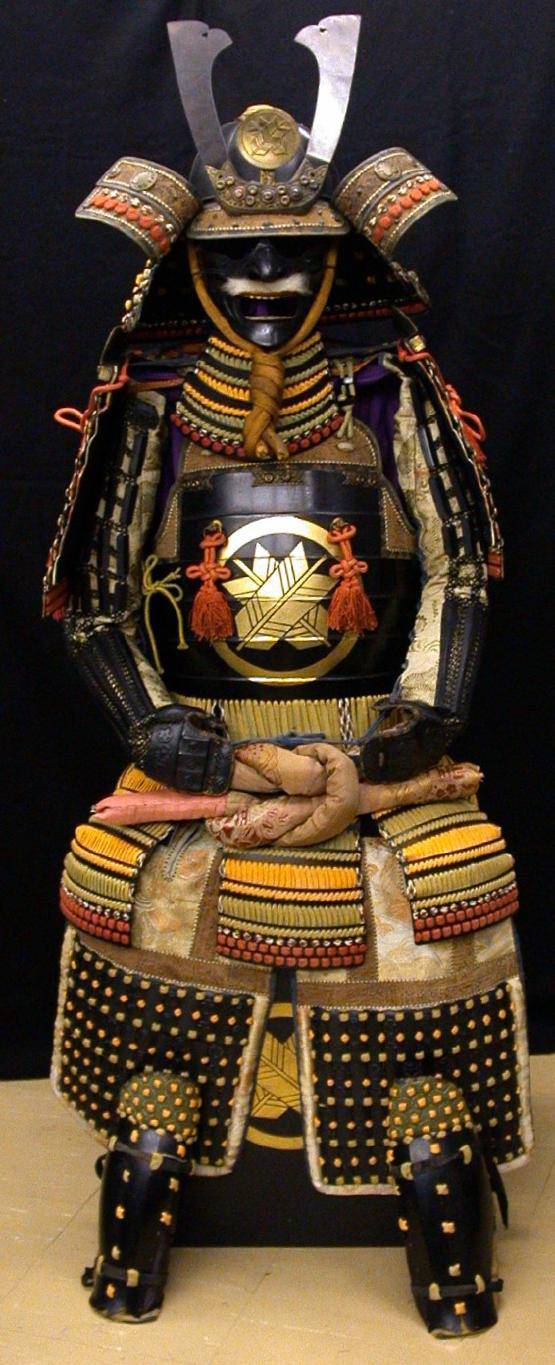
The armor of a noble samurai with a monom on his chest.
At the top of the banners was depicted the coat of arms of the family (Kamon or just Mon). Presumably the monks appeared around 1100 and were in circulation mainly among the court aristocracy. The origin of the first monks is attributed to the times of tribal totems, and their images were then vegetative and animal in character. For example, the butterfly was Tyra's coat of arms.
The monotony of badges underwent changes after the military actions of the Japanese against the Mongols, who twice tried to conquer the islands in the 13th century. After receiving a certain lesson in the conduct of the battle with the Mongols, the Japanese began to give preference to foot fighting, using long spears and wooden tate shields as weapons.
The purpose of tate was only the protection of shooters. Spearmen and swordtails no longer used portable shields. So, on the white shields then the family coat of arms was depicted, and one or several stripes going across. This combination of mona and stripes (a kind of identification mark of a military unit) was characteristic of the other insignia in the Japanese army. They could be seen on the shoulder and nape flags, the back banners.
Even for the distinctive signs used special pology - dzinmaku, which enclosed the rate of the commander. Initially they were used as curtains, insulating parts of the house from each other.
Since the XIV century. Jinmaku began to use in their everyday life and warriors. Dzinmaku were made of strips of matter, as a rule, they were 5 pieces. In height, such jinmaku reached 2-2,5 m. The strips were not completely sewn, leaving part of the canvas unstitched. The canvas let in air, and if a strong wind rose, it did not blow like a sail. And through them it was very convenient to observe what was happening outside. Mostly Jinmaku were white, with a black generic coat of arms in the center of the canvas in the middle lane. By the XVI century. Jinmaku became colored, the presence of several colors on the cloth was not forbidden. On multi-colored jinmaku, the coats of arms were white, yellow, or none at all, which made it possible for the spectators to try to guess the owner by the color matching.
Almost at the same time, personal insignia appeared on the armor. In times of Hempei, samurai Minamoto and Tyra sometimes tied on their armor ribbons of a certain color, which were specific to each clan. In the XIV century. such ribbons have been modified in sode-jirushi - sleeve ins and Kasa-jirushi - helmet-mounted flags.
Samurai with kasa-jirushi. Fig. A. Shepsa.
The sleeve flag was a rectangle of size 3-4 sun on 1 shaku (9-12 on 30 cm), attached to the upper edge of the sode shoulder strap with a narrow end. The kasa-jirushi was about the same size, with the difference that its upper part was wrapped around a wooden slat. The pattern of the sleeve and helmet badges was repeated in the pattern on the tate shields, but sometimes, as a supplement, it contained some inscription.
The period of the highest ascent for all sorts of identification marks can be considered the "Period of the Warring Provinces" (Sengoku Jidai), dating back to the XIV – XVI centuries. At that time, Japan was fragmented by more than 200 independent principalities that were rapidly emerging and just as quickly disappearing. Not one year without wars. Each prince, a daimyo, wanting to multiply and strengthen his army, recruited peasants, whom the army called ashigaru - "light-footed". Such a motley army needed iron discipline, and besides, for effective combat operations a certain system of identification marks and signals was required. One of the most significant inventions in the system of marks and signals was the invention of the back flag - sashimono. Similar signs are marked only twice in history: these are the famous “wings” of the Polish hussars of the XV – XVI centuries. and the back figures of animals used in the Aztec state as signs of belonging to the army. However, none of these signs could compete with the informativeness of sashimono.
Sashimono appeared presumably after 1485 g. Until that time, only decorative banner hata-jirushi were used. And only when a conflict broke out between the two lines of the Hatakeyama family in the province of Yamashiro. Then it became necessary to come up with distinctive signs so that the opposing sides could understand where their own is, where the alien is (the family coat of arms at that time was one for all). Therefore, one of the parties hastily changes the appearance of khat-jirushi: the top bar is attached to the shaft at one end. This L-shaped banner was called the Nobori.
The standard dimensions of the cloth were 1 shaky across (30 cm) and 3-4 shaky in length (90-120 cm). Bamboo served as a lightweight and very durable frame. The warriors passed the lower end of the shaft through the ring, which was on the armor or in the middle of the shoulder blades, or slightly higher, and then fixed in a special leather pocket at the back.
In addition to the traditional rectangular sashimono, sometimes came across square-shaped banners. There were some very unique specimens - poles with pommel in the form of the sun, a pumpkin carved out of wood, a coat of arms, and horns. They were used by the commanders of the ashigaru detachments in order to stand out from the crowd. Gradually, the samurai’s fantasy broke out, and behind them it became possible to see well, just incredible things - golden rice pestle, turnips with leaves (!), A food bag, a prayer flag and a prayer tablet, balls of black fur (or one black two white and vice versa), a golden lantern, an anchor, a Buddhist monk's staff or a golden fan! And one can not even talk about peacock feathers and fans made of feathers - nature itself suggested that it was both beautiful and weighing little.
There are several options for images on sashimono. Firstly, this is the image in the upper part of the Mona cloth, as in the old hata-jirushi. The most popular colors are black on white. Further descending went red, blue, brown and green. Very rarely sashimono was colored.
It was not a fundamental coincidence of the color of the coat of arms with the color of the additional bands.
Another type of images on the banners is close to the monks, but does not apply to them. Most often, these were the initials. For example, sashimono with a black circle in the upper part used Kuroda Nagamasa (kuro-da in Japanese means black field), samurai Ii Naomasa, the banner with the hieroglyph "and" ("well"), were worn on the banners the first hieroglyph of his surname is "hon" ("book").
Such an easily recognizable image made it possible to determine the belonging of the troops, and in addition, the hieroglyphs helped to clarify the military unit. For example, the guard of the Princes Hojo had a sashimono with the family coat of arms in the upper part of the cloth. Under it was placed one hieroglyph, strictly individual for each platoon of soldiers (the platoon numbered 20 soldiers). 48 platoons were a company of which there were seven. In different companies, the colors of sashimono, of course, were different - yellow, black, blue, red and white. It is interesting that when the army went a certain order, the hieroglyphs on the banners formed into a poem.
Banners of large sizes, necessary to designate the "headquarters" daimyo, as well as large military units, in the XVI century. had several types. The oldest, Hata-jirushi, was the rarest at that time. It is known that it was used by samurai clans that had ancient roots.
A different type of banner, nobori, was more common. Despite the differences in shape, the designs on these types of banners were similar. Unlike monochrome (sashimono), hata-jirushi and nobori were multi-colored.
The next type of samurai banners - the standard, was called mad-jirushi - "horse banner." Such a strange name originates from ancient history. Then, apparently, some signs made of horse tails were used. It seems such banners were in the Middle Ages, but they were not widely spread.
In the XVI century. the passion for originality led to the creation of a great variety of mind-jirushi of absolutely incredible forms. For example, Oda Nobunaga had a major standard (o-mind-jirushi) in the form of a huge red umbrella, and a red hat on a long pole served as a small standard (co-mind-jirushi). Coins (black circles with a square hole in the center) and yanome (the so-called "snake eye") —a ring with rather thick edges — were often depicted. For example, the Sanada family had a square shihan on which six black coins were depicted. It is noteworthy that the "Six Coins" were exclusively the military emblem of Sanada. In peaceful life, they used mon as a stylized wild duck (kari).
Another one of the most popular signs was fans, on which there were images of circles of various colors, as well as swastikas (mongaras), and images of various plants (plum flowers, cherries, oak leaves), as well as animals and birds.
Separate attention are all sorts of sayings inscribed on the banners. For example, the famous Takeda Shingen on a dark blue Nobori were golden hieroglyphs, forming a quote from the ancient Chinese writings of Sun Tzu: "Fast as the wind, slow as a forest, merciless as a fire, fixed as a mountain." This standard was abbreviated as Furinkadzan, meaning "Wind, forest, fire, mountain."

Nobori Takeda Shingen. Fig. A.Shepsa
Tokugawa Ieyasu had a white khata-jirushi, inherited from his father, with the motto of the Buddhist sect "Pure Land" - "Turning away from the earthly vale, happily embark on the righteous path leading to the Pure Land."
And Ishida Mitsunari hieroglyphs on white nobori formed into the motto, meaning “Great, huge, ten thousandth luck”. It is interesting that they were composed in the form of a crossword puzzle and at the same time were the owner's coat of arms, which was a unique case, because the hieroglyphs were used in the coat of arms very rarely and only in combination with any pattern.
A unique inscription was on the banner of Ban Naoyuki. The inscription on his white Nobori read: "Handan Wemon", denoting "Right Palace Guard. Escort detachment". Then all the famous guards were divided into right and left. Apparently, either Naoyuki himself, or maybe one of his ancestors had the honor to serve in the palace guard and to bear the title, called in this way.
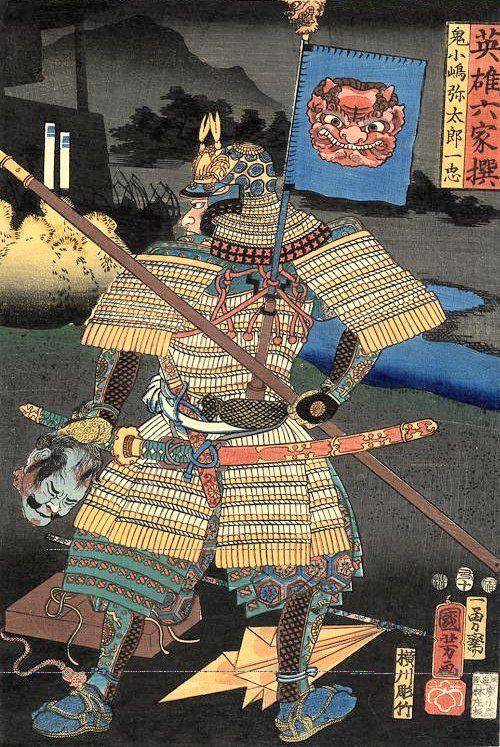
In this engraving, Utagawa Kuniyoshi clearly shows how the sashimono was attached to the dorsal section of Japanese armor.
What in all this was terrible for a European? Yes, that any identification system with the help of various signs inside the clan was completely absent, and in addition there were a lot of them! For example, Koyde Yositika, who fought in the battle for Osaka for Tokugawa, had a white nobori with a black KO hieroglyph in a black circle, but the standard was a gold cross with bizarre endings, but his samurai wore sashimono as a pole with five double gold flags! Tozavo Masamori, also a Tokugawa supporter, had sashimono messengers in the form of a red disk on a blue field and with black fur plume, but samimono samurai and ashigaru are the same, but smaller and without plume. Then he had a flag standard with the same image and the same color that was hung on the crossbar under the golden antlers. He had a large standard opposite - he looked like a pole with three golden umbrellas one above the other and a black plume of feathers, but he had a black and white transverse strip of nobori.
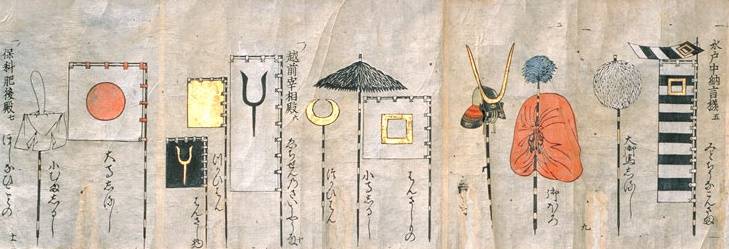
Identification marks of Japanese samurai. Old woodcut.
The clan Tsugaru, who was in northern Japan, had a crazy jirushi in the form of a voluminous shakujo - a staff with a rattle of a Buddhist monk, so large that it had to be worn by three asigaras: one carried him on his back, and the other two stretched him on cords so that he not very swinging. The red sasimon of the samurai depicted a golden swastika, and on the white nobori two red swastikas were depicted. The small standard was white with a golden circle in the middle, but the assistants of the standard bearer with shakujo - two simple red flags at once!
But everyone seemed to have surpassed a certain Inaba, who died in 1628, who had sashimono ashigaru in the form of a triple (!) Flag with three white circles on a blue background, then sashimono messengers - a white hieroglyph on a blue background, then sashimono samurai - out of five golden feathers on a pole, then a large standard — a golden bag for food, a small standard — a pestle for rice, and finally, a nobori — a white circle on a blue field (one), that is, six different identification marks! And all this had to be remembered and all this to understand, in time to determine who in front of you are friends or enemies!
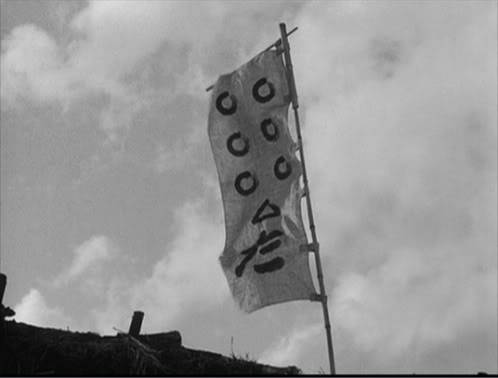
Nobori from the movie "Seven Samurai" - six icons - six samurai, one icon - a peasant son and at the bottom a hieroglyph designating a village.
It is obvious that, both in armament and in all sorts of means of identification, the Japanese warriors were distinguished by uncommonness. And some insignia of the samurai do not have analogues in the world.
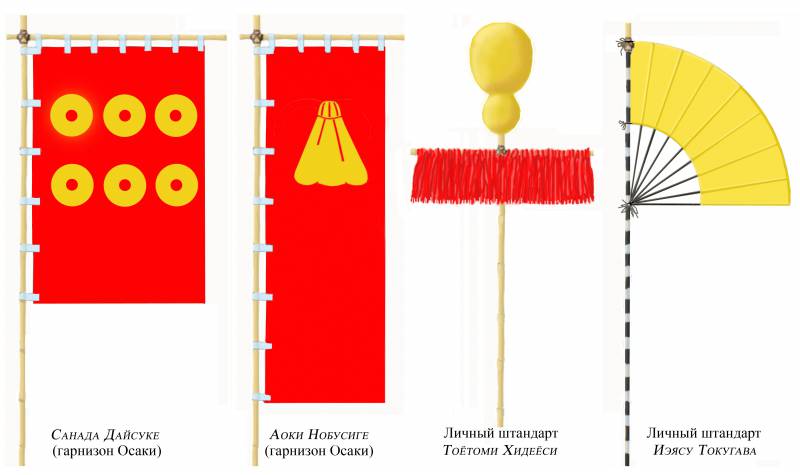
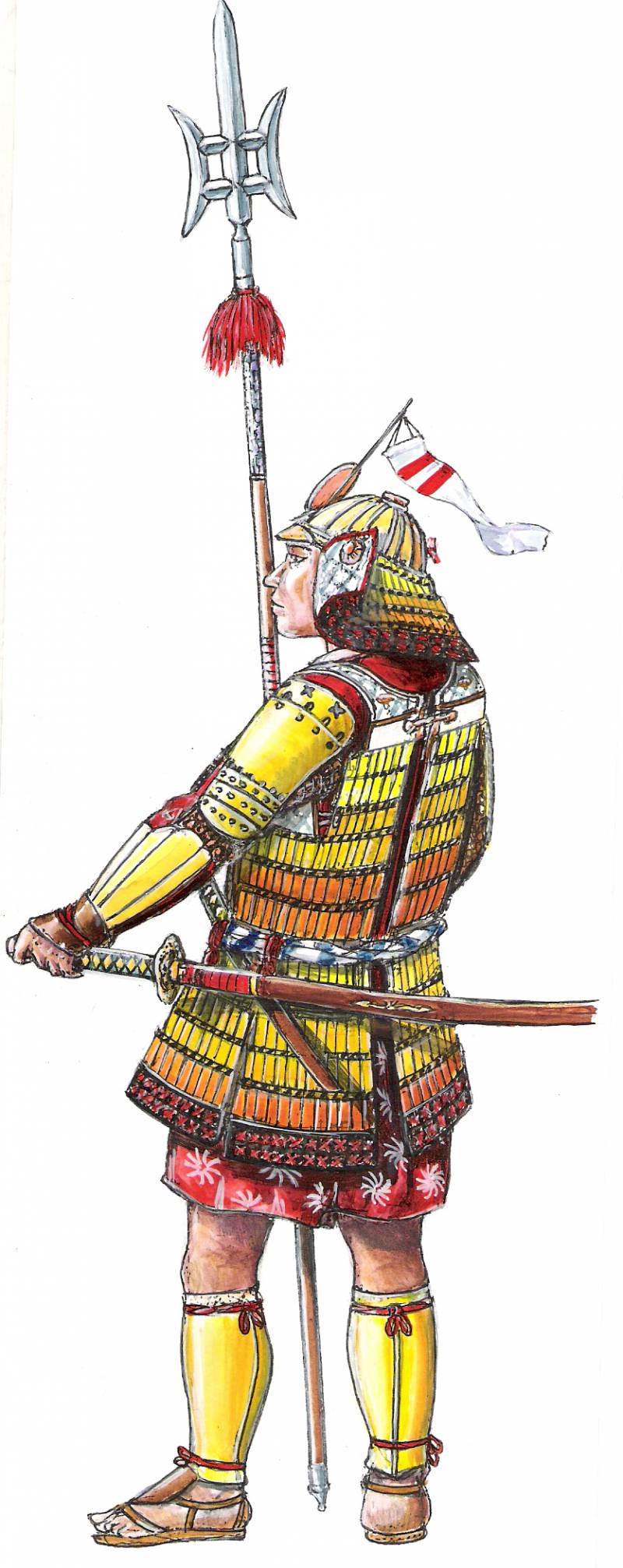
Information